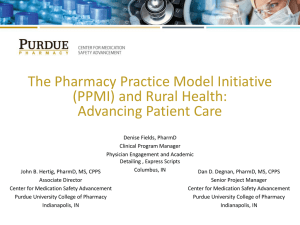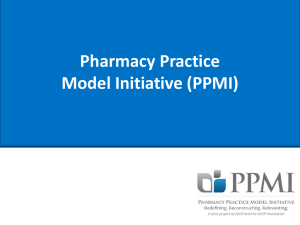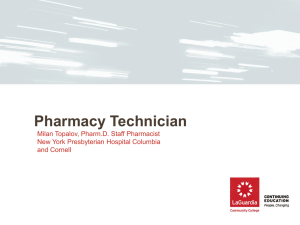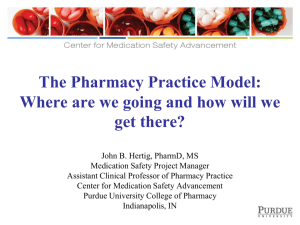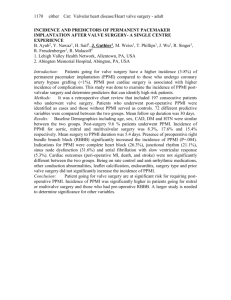Pharmacy Practice Model Initiative Empowering Students to
advertisement
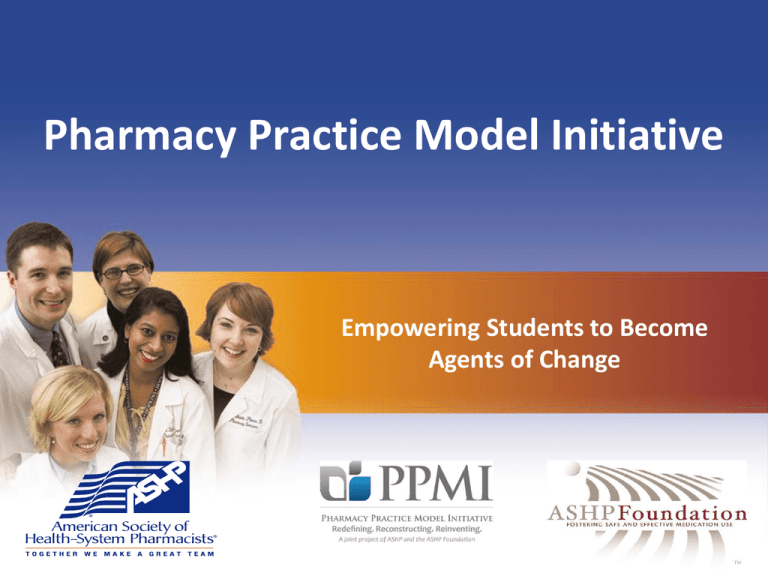
Pharmacy Practice Model Initiative Empowering Students to Become Agents of Change Shhhhhhh… For event updates: www.twitter.com/ASHPMidyear #ashpmidyear Session Agenda • PPMI Overview • Practitioners Prospective • Interactive Session • Important Resources Goal: Develop and disseminate a futuristic practice model that supports the effective use of pharmacists as direct patient care providers www.ashp.org/PPMI Pharmacy Has Come a Long way… 1960’s Unit Dose 1990 Surfactant 1993 Pharmaceutical Care 20022008 20032008 1.5% 21.5% 5.9% 11.4% Bedside Barcode CPOE with CDS Historical Perspective ASHP Hilton Head Conference, 1985 “ To bring about change within a diverse profession such as pharmacy, one needs a large number of people pulling in the same direction. Before one can get folks pulling in the same direction, one needs general agreement about the best direction in which to move.” -William A. Zellmer www.ashp.org/PPMI Vision The initiative and summit will create passion, commitment, and action among hospital and healthsystem pharmacy practice leaders to significantly advance the health and well being of patients by optimizing the role of pharmacists in providing direct patient care. www.ashp.org/PPMI Initiative and Summit • Invitational Summit • Social Marketing Campaign • Raise awareness • Stimulate discussion • Disseminate the findings • Initiative Grants 5 PPMI Focus Areas 1. Create a Framework 2. Determine Services 3. Identify Emerging Technologies 4. Develop a Template 5. Implement Change www.ashp.org/PPMI PPMI Summit, Dallas, Texas November 7 – 9, 2010 • Two-day invitational event that included approximately 150 pharmacist participants • Issue Briefings commissioned • Plenary presentations and work groups followed by a consensus process to address key outcomes to develop a new pharmacy practice model PPMI Pre-Summit Survey Results Divided into Sections: 1. Overarching Principles 2. Services 3. Technology 4. Technicians 5. Implementing Change and Responding to Challenges Section 1: Overarching Principles • Consensus on the following principles: Opportunity to advance the health and well being of patients by changing the practice model Financial pressures will force changes in how resources are used Every pharmacy department should identify drugtherapy management services provided consistently by pharmacists In the coming years, there will be increasing demand among new pharmacy graduates for residency training Section 2: Services • Essential services should include: Tracking and trending pharmacist interventions Medication reconciliation at transitions in care All patients deserve the care of a pharmacist. It is recognized that resources will need to be allocated according to the complexity of patients and organizational needs. Section 3: Technology • Technology priority order of importance: Electronic medical record systems Use of barcode technology during medication administration Real-time monitoring systems that provide a work queue of patients needing review and possible intervention • Pharmacy residency programs should provide informatics training Section 4: Technicians Pharmacy technicians who have appropriate education, training, and credentials should be used to free pharmacists from drug distribution activities Assigning medication distribution tasks to technicians would make it possible to deploy pharmacists to drug-therapy management services Uniform national standards should apply to the education and training of pharmacy technicians To support optimal pharmacy practice models, technicians must be licensed by state boards of pharmacy Section 5: Implementing Change • Further support for the requirement of residency training • Support from health care executives, pharmacy department and clinical pharmacy leadership Practitioners Prospective Influencing others to buy into change… • Implementing the futuristic practice model will require incremental changes Embracing change, not resisting change Change management requires careful planning • Addressing the conceptual, psychosocial, and methodological aspects to change • Examples of change in pharmacy • Experience with influencing others to buy into change Department Organizational State National • How you will implement the outcomes of the summit in your own practice Hold your own summit Debate the hot topics Residency training Mentoring PPMI Case Roundtables How are you going to be an agent of change? Timeline of Session • 10 minute brainstorming session • 5 PPMI cases to discuss • 3 groups will be chosen to present their case • Wrap-up and closing at 3:55 PM PPMI Case Roundtables • Case #1 Create a Framework • Case #2 Determine Services • Case #3 Identify Emerging Technologies • Case #4 Develop a Template • Case #5 Implement Change Resources to Facilitate Involvement Arming you with tools to help advance practice How can YOU get involved? Virtual Participants Tweeted Group Pictures of their Sites John Hopkins Hospital Pharmacy University of Cincinnati SSHP Harding College of Pharmacy Henry Ford Pharmacy Summit Materials Perspectives and Resources Pharmacy Spotlight Summit Webcast Archives http://prestonevents.com/reg/ppmi/ What’s Next? • Consensus Statements • Resources Summit Proceedings (Spring 2011) Briefing Documents (Spring 2011) Self Assessments/Practice Based Tools • Demonstration Grants • SSHP Recognition Projects http://www.ashp.org/Import/MEMBERCENTER/StudentForum/Stu dentSocieties/Tools/Empowering-Students.aspx • Upcoming Meetings Summer Meeting 2011 and MCM 2011 Major Themes • Moving the pharmacist closer to the patient • Greatly expanding the role of a qualified technician workforce and the use of technology • Ensuring that pharmacy departments are accountable for the development and implementation of medication use policy to ensure safe and effective use of medications • Working to assure pharmacists are accountable for patient outcomes. Igniting your Passion for Change: 3 Take Home Points • Be Bold • Think Outside the Box • Hit the Ground Running For more information: www.ashp.org/PPMI Email: students@ashp.org
